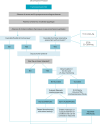Decannulation protocol in pediatric patients: case series study
- PMID: 39319994
- PMCID: PMC11421412
- DOI: 10.1590/1984-0462/2025/43/2023187
Decannulation protocol in pediatric patients: case series study
Abstract
Objective: The aim of this study was to describe the phases of a decannulation protocol and the results from its application in hospitalized children.
Methods: This is a retrospective, observational study. Data were collected from medical records of decannulated patients followed up in a pediatric hospital in Belo Horizonte, Minas Gerais between 2011 and 2021.
Results: Among the children followed up in the service (n=526), 23% (n=120) were successfully decannulated. Children aged between 2 months and 16 years, with a mean age of 4 years, 69% of whom were male, were evaluated. About 75% of the patients have tracheostomy due to upper airway obstruction and 60% of these due to acquired subglottic stenosis. At the beginning of the decannulation protocol, 5.5% of the patients had moderate oropharyngeal dysphagia, while 80.4% had normal swallowing. Correction in the upper airway pre-decannulation was performed in 39.5% of the patients, dilation in 63.8%, and endoscopic correction was performed in 55.3%. After performing the decannulation, none of the patients had complications.
Conclusions: The described decannulation protocol is safe, since no complications such as death and need for recannulation happened.
Objetivo:: Descrever as etapas de um protocolo de decanulação e os resultados da aplicação desse protocolo em crianças hospitalizadas.
Métodos:: Trata-se de um estudo observacional retrospectivo. Os dados foram coletados de prontuários de pacientes decanulados acompanhados em um hospital pediátrico de Belo Horizonte, Minas Gerais, entre 2011 e 2021.
Resultados:: Foram analisadas 120 crianças com idade entre dois meses e 16 anos, com média de idade de quatro anos, 69% das quais eram do sexo masculino. Cerca de 75% dos pacientes apresentam traqueostomia por obstrução de vias aéreas superiores e 60% destes por estenose subglótica adquirida. No início do protocolo de decanulação, 5,5% dos pacientes apresentavam disfagia orofaríngea moderada, enquanto 80,4% apresentavam deglutição normal. A correção da pré-decanulação das vias aéreas superiores foi realizada em 39,5% dos pacientes, a dilatação em 63,8% e a correção endoscópica em 55,3%. Após a realização da decanulação, nenhum paciente apresentou complicações.
Conclusões:: O protocolo de decanulação descrito é seguro, pois a taxa de complicações como óbito e a necessidade de recanulação foi ausente.
Conflict of interest statement
References
-
- Vianna A, Palazzo RF, Aragon C. Traqueostomia: uma revisão atualizada. Pulmão RJ. 2011;20:39–42.
-
- Pozzi M, Galbiati S, Locatelli F, Clementi E, Strazzer S. Performance of a tracheostomy removal protocol for pediatric patients in rehabilitation after acquired brain injury: factors associated with timing and possibility of decannulation. Pediatr Pulmonol. 2017;52:1509–1517. doi: 10.1002/ppul.23832. - DOI - PubMed
Publication types
MeSH terms
LinkOut - more resources
Full Text Sources


